The Dressage Ring
Dressage riders are required to dress formally in recognized competition. Current and retired members of the Armed Services and police units are permitted to wear their respective uniform.
 The dress code for all Dressage tests and classes through Fourth Level is a short riding coat of conservative color, with tie, choker or stock tie, white or light-colored breeches or jodhpurs, boots or jodhpur boots, and protective headgear. A cutaway coat (modified tailcoat) with short tails is permitted. Half chaps, gaiters and/or leggings are not allowed. Gloves of conservative color are recommended. Exception: Riders through First Level may wear half-chaps, gaiters or leggings in solid black or brown, without fringe, matching the color of their boots, and made of smooth leather or leather-like material.
The dress code for all Dressage tests and classes through Fourth Level is a short riding coat of conservative color, with tie, choker or stock tie, white or light-colored breeches or jodhpurs, boots or jodhpur boots, and protective headgear. A cutaway coat (modified tailcoat) with short tails is permitted. Half chaps, gaiters and/or leggings are not allowed. Gloves of conservative color are recommended. Exception: Riders through First Level may wear half-chaps, gaiters or leggings in solid black or brown, without fringe, matching the color of their boots, and made of smooth leather or leather-like material.
–2013 USEF Rule Book
 Coat: Choose a dressage coat in black or navy. This is the most important part of your outfit. The Feather Lite Dressage Coat by Romfh is a great option. Dressage coats differ from hunt coats in that they have four buttons, while hunt coats have only three.
Coat: Choose a dressage coat in black or navy. This is the most important part of your outfit. The Feather Lite Dressage Coat by Romfh is a great option. Dressage coats differ from hunt coats in that they have four buttons, while hunt coats have only three.
Ties: Accent a show shirt with a stock tie for women or a conservatively colored tie for men.
Breeches: White breeches are most common in dressage competition. Full seat breeches help the rider stick in the saddle. A conservative belt will polish off your look.
Boots and Half Chaps: Tall dress boots or field boots in black are most common in the dressage ring. The Mountain Horse Firenze Dress Boots and Petrie Olympic Dress Boots are both great options. At lower levels, you may instead wear paddock boots and half chaps that match in color and closely resemble the look of a tall boot. A good option is the Tredstep DeLuxe Leather Half Chap.
Gloves: Not only will gloves complete your look, they also protect your hands from blisters and help provide grip on the reins. They are usually white in the dressage ring, although black is also acceptable. Gloves can be found in a variety of fabrics. Choose the best style and fabric for your budget and comfort.
Spurs must be made of metal. The shank must be either curved or straight pointing directly back from the center of the spur when on the rider’s boot. If the shank is curved, the spurs must be worn only with the shank directed downwards. However, swan necked spurs are allowed. The inside arm of the spur must be smooth and one or both arms may have rubber covers. If rowels are used, they must be blunt/smooth and free to rotate. Metal spurs with round hard plastic knobs on the shank are allowed (“Impuls” spur). “Dummy” spurs with no shank are also allowed.
–2013 USEF Rule Book
Spurs: A few good options for spurs that are appropriate for use in dressage competition include the Korsteel Tom Thumb Prince of Wales Dressage Spurs, Korsteel Swan Neck Spurs, and Stubben Soft Touch Spurs.
The Hunter Ring
Hunter riders will get a competitive edge by dressing conservatively and neatly. Current and retired members of the Armed Services and police units are permitted to wear their respective uniform.
Riders are required to wear scarlet or dark coats; white shirts with white stock; white, buff or canary breeches and protective headgear.
–2013 USEF Rule Book
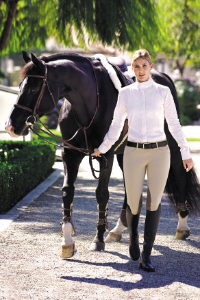 Coat: If you’re a member of a recognized hunt and have earned your colors in the field, you may wear a red coat. Otherwise, choose a dark colored coat. Patterns that appear solid at a distance are acceptable.
Coat: If you’re a member of a recognized hunt and have earned your colors in the field, you may wear a red coat. Otherwise, choose a dark colored coat. Patterns that appear solid at a distance are acceptable.
Shirt: Your shirt should be white, and it should match your coat. You can choose a long-sleeved, short-sleeved, or sleeveless shirt. For equitation classes, consider a monogram on your shirt collar.
Breeches: Choose white or tan colored breeches in either a front- or side-zip style. Pair breeches with a conservative belt that matches your boots.
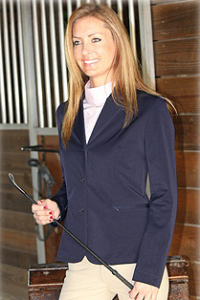 Boots: Tall, black leather boots are best for adult riders. The Ariat Heritage Contour Field Boot and the Ariat Challenge Contour Field Boot are options.
Boots: Tall, black leather boots are best for adult riders. The Ariat Heritage Contour Field Boot and the Ariat Challenge Contour Field Boot are options.
Gloves: Choose black gloves for the hunter ring. There is a wide variety of styles and fabrics of gloves available, so shop around to see what works best for you, and be sure to ride in your gloves prior to competition.
Helmet: Protective headgear is mandatory and should be ASTM/SEI certified. Black helmets with minimal ornamentation are suitable. Long hair should be completely contained within your helmet underneath a hair net.
The Jumper Ring
In the jumper ring, a wider variety of attire is acceptable, although you should always aim for a neat appearance in competition. Current and retired members of the Armed Services and police units are permitted to wear their respective uniform.
Black, blue, green, grey, scarlet or similar coats are permitted; white or fawn breeches; a white tie, choker or hunting stock, and a white or lightly colored shirt must be worn. Shirts must have a white collar and white cuffs. Management, at its discretion, may allow competitors to compete without riding coats. If a riding coat is not worn, riders must wear a shirt with a collar or a choker, neatly tucked into riding breeches. A windbreaker jacket or raincoat may be worn if conditions require.
–2013 USEF Rule Book
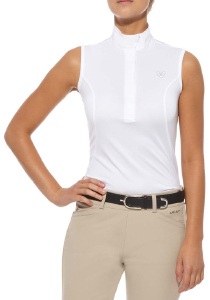 Coat: Choose a coat in a color that compliments both you and your horse. For jumper competition, a coat with some stretch will allow mobility in the saddle.
Coat: Choose a coat in a color that compliments both you and your horse. For jumper competition, a coat with some stretch will allow mobility in the saddle.
Shirt: Your shirt should be light-colored with a collar. You can choose a long-sleeved, short-sleeved, or sleeveless shirt. For more informal competitions, well-fitted polo shirts are acceptable.
Breeches: Choose white or tan colored breeches in either a front- or side-zip style. Pair breeches with a belt for a professional, put-together look.
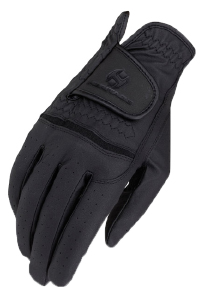 Boots: Tall, black leather boots are best for adult riders. The Ariat Heritage Contour Field Boot and the Ariat Challenge Contour Field Boot are excellent options. Boots should be clean and polished.
Boots: Tall, black leather boots are best for adult riders. The Ariat Heritage Contour Field Boot and the Ariat Challenge Contour Field Boot are excellent options. Boots should be clean and polished.
Gloves: Gloves are optional, although common in the jumper ring. There is a wide variety of styles and fabrics of gloves available, so shop around to see what works best for you. Be sure to ride in your gloves prior to competition!
Helmet: Protective headgear is mandatory and should be ASTM/SEI certified. Long hair should be tucked into your helmet, preferably with a hair net.
The Western Ring
Western riders should appear polished and conservatively dressed, paying careful attention to their silhouette on the rail. Color plays a very important role in the impression that you make in the show ring, and you should take into consideration your horse’s coloring. Also remember that you should dress to play up your strengths: dark colors minimize, while light colors emphasize.
Riders must wear Western hat; long-sleeved shirt any type of collar, trousers or pants and boots; (a one-piece long-sleeved equitation suit is acceptable provided it includes any type of collar). Chaps, shotgun chaps and spurs are optional unless riders are showing in trail or pleasure class. A vest, jacket, coat and/or sweater may also be worn. Protective headgear may be worn without penalty; not required.
–2013 USEF Rule Book
 Shirt: A show shirt is the foundation of your western show outfit, and a tailored, flattering fit is crucial. Traditional, solid-colored blouses are a timeless, budget-friendly look. They are preferred for those who show in events like reining or cutting, where freedom of movement is paramount. Rhinestones, patterns, and color can help riders stand out and shine in rail classes.
Shirt: A show shirt is the foundation of your western show outfit, and a tailored, flattering fit is crucial. Traditional, solid-colored blouses are a timeless, budget-friendly look. They are preferred for those who show in events like reining or cutting, where freedom of movement is paramount. Rhinestones, patterns, and color can help riders stand out and shine in rail classes.
Pants: Classic jeans can work, but they can often make for a bulky fit under chaps. The best choice is a pair of fitted pants with a hint of stretch. You can even consider trying English breeches. Just make sure they have belt loops wide enough for your western belt! Pants should always match your chaps in color.
Chaps: Chaps are the most important element of a winning western wardrobe. A flattering fit will set the tone for your entire ensemble. They should hang snugly off your waist, and they should cover your pants belt when you are mounted. There should not be any gapping at the front of your thigh. They must be long enough to cover your boot heel when in the saddle.
Belts and Buckles: A plain belt that matches your pants and chaps is the most flattering look. Western belt buckles come in an endless variety of shapes and sizes. Always choose a buckle that is proportionate to you. If you can, wear the buckle you just won.
Boots: Think about how your boots will look peeking out from under your chaps, through your stirrups. Match the color to your chaps. Fatbaby styles should be avoided in the show ring, since they can break up the clean line under your chaps.
Hat: Subtle differences in quality, shape, and maintenance of your hat expose the horseperson underneath. Your hat should fit comfortably and stay on in a stiff breeze, and it should flatter your facial structure as well as punctuating the rest of your outfit. Generally your hat should match your chaps, although a bright white hat can help you stand out with dark chaps.
Accessories: These are the finishing touches to help you stand out. Earrings will frame your face and harmonize your look. They should be about an inch in diameter or smaller. Avoid dangling earrings, which can be distracting an uncomfortable. A scarf helps complete your look and add some flair.
Spurs: Your spurs should be effective on your horse, but they should also look nice. Spur straps can sport pretty buckles or fancy straps with conchos and tooling.

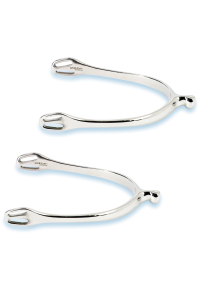
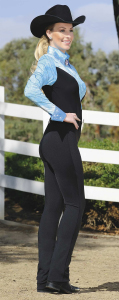
Good blog post. I definitely love this site. Keep it up!
I like that you mention having a tailored flattering fit for your shirt for a western show. I’d imagine that this could also be useful for the other competitions and shows as well.